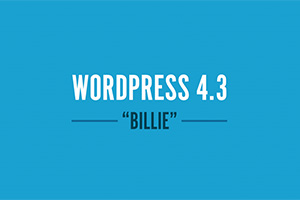
Improvements in Password Creation
Weak passwords are a major issue with the security of a website. WordPress 4.3 takes some steps to address this, primarily in the area of password creation.
To start, when a new password is being created, the program will send users a reset link via email rather than sending out the password in the body of the email. This should help cut down on passwords being compromised.
Further, when a password recovery link is emailed to a user, that link will only be viable for a set period of time. By setting these links to automatically expire WordPress will decrease instances of old links being used to reset passwords if a user’s email account is compromised.
Finally, when a new password is being created, WordPress 4.3 will automatically fill in the field with a “strong” password. This should help those users who struggle coming up with their own strong passwords.
Comments on Pages Default is Now Set to Off
In previous versions of WordPress users were required to change the comments setting on each page they added to disable comments on static pages. This could prove tedious, especially for those users who added substantial amount of content. WordPress 4.3 will default to No Comments for static pages while leaving comments enabled for post pages. This change should save users some time and frustration.
Changes in the Visual Editor
When creating a post in older versions of WordPress users had to continually move their hand to the mouse, select a formatting button, and click it. While doing this occasionally is no big deal this can dramatically slow down the pace of someone who has to do it over and over.
WordPress 4.3 will address this by creating inline text shortcuts. Instead of clicking on a button the user will simply type in the shortcut and WordPress will translate the text into HTML. This will be useful when creating lists, headings, and the like.
Four shortcuts have been added:
- Use * or – like bullet points for unordered lists.
- Use 1. or 1) for ordered lists.
- # will be converted into header tags, depending on how many you use, # for H1, ## for H2, ### for H3, etc.
- Use > for blockquotes.
Ability to Upload Site Icons
In the past a user wishing to change the icon displayed next to the site name in the URL box of a web browser, was required to either use a plugin to add it, or change their theme files to display the desired favicon. WordPress 4.3 greatly simplifies the process to change a site icon: just select the icon you wish to use, upload it, crop it if necessary, and check the preview to verify that it’s what you want.
Other Changes
There are a number of other changes. These won’t be as easily apparent, but they include changes to the way shared terms on multiple taxonomies are handled, changes to the default template for certain types of pages, and more.
- The mostly unloved Distraction Free Writing Mode has been scrapped. (#30949)
- Shared taxonomy terms will now be segregated. (#30261)
- Users on mobile devices will no longer have columns truncated in list view. Instead, they can be toggled in and out of view. (#32395)
- You can now define the primary column in list tables. (#25408)
Conclusion
Please note that this list is not all-inclusive and there are other changes that you may find to be useful. Spend some time reading about the new features of WordPress 4.3, and you may be surprised at how readily you adapt to the new changes.

